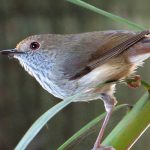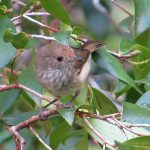BROWN THORNBILL
Brown Thornbills are small birds, measuring about 10 to 12 cm in length. They have a distinctive brown plumage on their upperparts, while their underparts are paler with a cream or buff-colored throat. They have a tiny, slender bill and a short, square-ended tail.
Brown Thornbills are found throughout most of Australia, except for the northern and western regions. They are most common in the eastern and south-eastern parts of the country.
These birds inhabit a variety of wooded environments, including eucalyptus forests, heathlands, and gardens. They are particularly fond of dense undergrowth and shrubby areas.
Brown Thornbills are insectivores, primarily feeding on insects, spiders, and other invertebrates. They forage for food by gleaning from leaves, branches, and bark, and they often search for hidden prey in tree crevices.
Brown Thornbills breed during the spring and early summer. They build cup-shaped nests, which are typically located in dense vegetation, shrubs, or low trees. The nests are often well concealed and made of plant materials, such as bark, grass, and spider webs, which help bind the nest together. The female typically lays 2 to 4 eggs, and both the male and female take turns incubating the eggs and feeding the chicks.
Brown Thornbills are social birds and are often seen in small family groups or mixed-species flocks with other small birds. They communicate with each other through soft, tinkling calls.
They are known for their ability to mimic the calls of other bird species, which can make them challenging to identify by sound alone.
These small, active birds are a common and charming sight in many Australian woodlands and gardens, where they play a valuable role in controlling insect populations.


